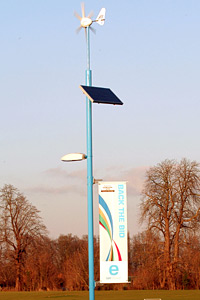Welcome to solar power from Marlec, a reliable, portable, non-polluting technology that produces electricity direct from sunlight!
 Harnessing the power of the sun can provide you with energy for lighting, tv, pumps, navigation equipment, laptop computers, mobile phone battery chargers, electronic devices and many other electrical appliances. You can have the convenience of all this equipment at your home, boat, caravan or remote site supplied through a 12V battery. Read on to find out how.
Harnessing the power of the sun can provide you with energy for lighting, tv, pumps, navigation equipment, laptop computers, mobile phone battery chargers, electronic devices and many other electrical appliances. You can have the convenience of all this equipment at your home, boat, caravan or remote site supplied through a 12V battery. Read on to find out how.
HOW DOES IT WORK?
A photovoltaic (pv) panel consists of a number of silicon cells (usually 36) connected internally in series. When light reaches these cells electrons are caused to drift which produces an electric current. This current varies with the size of individual cells and the light intensity.
WHAT CAN IT SUPPLY?
PV panels are usually used to charge 12v batteries for a wide variety of uses from telecommunications and navigation systems, remote third world villages to caravans, holiday cottages and boats. Single panels are available in sizes from 5 Watts to 170 Watts and can be connected in parallel to give higher currents or in series to produce higher voltages. (Note: when connected in series panels must be of equal current rating).
WHAT POWER OUTPUT CAN I EXPECT?
Whenever exposed to daylight PV panels will produce a more or less constant output voltage. This means that even in temperate zones in winter a useful charging current can be produced. This output current however does vary with light intensity. The rated output of all panels are measured by a standard illumination of 1kw/m (1 sun) at a temperature of 25°c. All BP Solar and SunWare PV panels are tested individually!
For example you could expect the following average daily amp/hrs from modules mounted at their optimum tilt angle facing south.
| Location | Module (watts) | Summer Ah per Day | Winter Ah per Day |
| London | 10 30 60 |
3.51 10.4 20.9 |
0.41 1.14 2.29 |
| Edinburgh | 10 30 60 |
3.21 9.55 19.1 |
0.22 0.67 1.32 |
HOW ARE SOLAR PANELS INSTALLED?
PV panels are easy to install, having no moving parts and are virtually maintenance free except periodical cleaning. They are usually mounted on brackets from a pole, wall or a roof and should be south facing (in the Northern Hemisphere). They should be inclined at an angle (from horizontal) relative to the latitude of location (between 65° & 75° for British Isles). They can be mounted flat such as on a caravan roof or boat deck which can mean better performance on overcast days. If panels are mounted at less than 15° they should be cleaned more often as flatter angles do not take full advantage of the cleansing effect of rainfall. A steeper angle in winter and a flatter angle in summer will improve output and a system where the angle can be manually altered seasonally will generate more power overall. Careful siting is important to ensure maximum exposure to sunlight for the longest possible time. If panels are shaded output will be reduced.
HYBRID SYSTEMS!
PV panels are ideal for use in a combined system with Windchargers, they can even be mounted on the same pole. Hybrid systems provide a more consistent seasonal power supply – higher winds in winter and more intense, longer hours of sunshine in summer. The balance between wind and solar power obviously depends on the location.